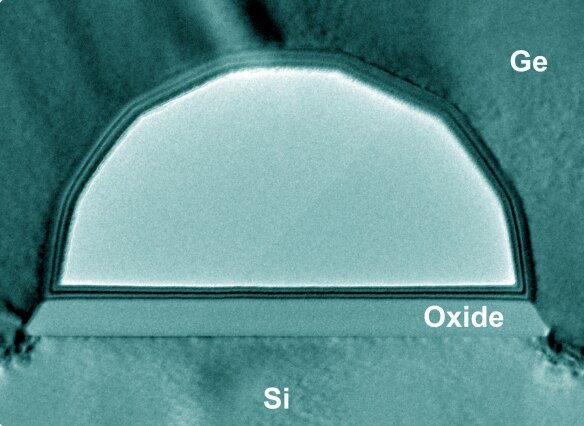I’ve written several times in recent months about how research into nanobots for use in medicine is exploding, and new discoveries are paving the way to a future where we combat disease, viruses, and cancers at their source. New research from MIT could potentially play a major role in that future, and it’s all thanks to a newly discovered property of the electrical engineer’s old friend, Germanium.
Germanium is one of the fundamental components that make up modern electronics, and if it were not for germanium, we would not have discovered fundamental components such as the modern transistor, or the LED for that matter. In fact, Germanium is used in virtually every modern electronic device as it’s used to increase the electrically conductive properties of silicon, but if you are reading this, you already know that.
A silicon oxide strip on a silicon (Si) base drives germanium (Ge) to form an archway-shaped tunnel centered directly over the oxide strip, MIT researchers have discovered. Transmission electron microscope image is taken in line with the silicon oxide strip along its length, like looking straight down the barrel of a rifle. Caption Credit: MIT | Image Credit: Rui-Tao Wen, adapted with permission from Nano Letters/American Chemical Society
What I am willing to bet that you do not know is that Germanium likes to form little domes, or pockets of empty space, when it’s crystals are grown on top of silicon patterned materials such as silicon dioxide and silicon nitride. Researchers have known about these little domes for years, but have only recently begun looking into how to manipulate them into something useful.
The team from MIT has devised a way to not only predict how the tunnels will form, but they can control their width and length as well. This opens up massive possibilities such as microscopic fluid delivery tunnels, highly localized medicine delivery. The tunnels can even function as light pipes and can theoretically be used for data delivery in nano-scale fiberoptic systems.
“We found a tunnel or cavity on top of the silicon dioxide which is between the germanium and the silicon dioxide, and we can vary the length of the tunnel depending on the length of the oxide,” says Rui-Tao Wen, a former MIT postdoc and first author of a recent paper in Nano Letters. Wen is now an assistant professor of materials science and engineering at the Southern University of Science and Technology in Shenzhen, China.
Utilizing a two-step process, the team was able to grow these tunnels by first depositing a layer of germanium at a lower temperature, and then adding a second layer of germanium on top at a much higher temperature. All of this is done on top of a silicon oxide strip, and the result is a tiny tube just nanometers thick.
“The major discovery was that you form these cavities or tunnels, and they’re actually reconfiguring during growth or annealing,” says Jurgen Michel, Materials Research Laboratory senior research scientist and senior lecturer in the Department of Materials Science and Engineering. “The reconfiguration internally is a basic scientific phenomenon that I don’t think anybody would have expected.”
The team discovered this after imaging the tunnels with a transmission electron microscope (TEM) at different stages of their growth. The expected outcome was that the tunnels would stay the same, but the images showed something very different. The tunnels were actually changing shape and evolving overtime. What was even more interesting is that the images showed that the surfaces inside the tunnel are atomically perfect, meaning they are perfectly flat at the atomic scale. Unlike other processes, the one used by the team was able to produce tunnels with perfect crystalline structures.
“This is something that nobody has observed yet, that you can actually get this, what we call internal reconfiguration of material,” Michel says. “So for instance, the tunnel gets larger, some of the connected material completely disappears, and the tunnel surfaces are perfect in terms that they are atomically flat. They form actually what are called facets, which are certain crystallographic germanium orientations.”
Researchers say that the tunnels experienced about 10 millibars of pressure during testing, which equates to about 100-times less than the atmospheric pressure one would experience at sea level. This shows promise for using the tunnels as a method to deliver nanomedicines to highly precise locations via a nanobot. One could imagine a swarm of nanobots armed with tiny germanium-tunnel injection devices attacking a tumor deep in someone’s brain, killing off the tumor one cell at a time.
While we are still not at a point where the medical nanobot scenario is feasible, discoveries such as this are paving the way to a future where a dose of nanobots might just be what the doctor ordered. I am very passionate about the future of nanobots, nanomedicine, and the further miniaturization of technology in general, so I would love to know your thoughts on this new breakthrough. I only scratched the surface here, so please head over to the more in-depth article on MIT’s website at the link below.
Source: http://news.mit.edu/2020/new-facet-germanium-tunnels-0131

